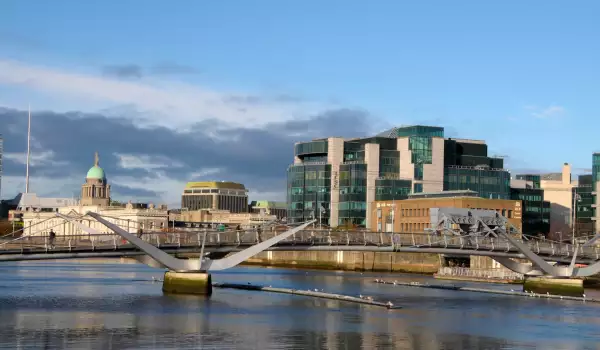Dublin

Ireland is also called the Emerald Isle - because of the incredible beautiful scenery, which is the result of the geographic location of the island. There the weather is unpredictable, often dark and rainy, but the Irish still remain one of the most cheerful, hospitable and smiling people. They definitely know how to have fun and it's no surprise that Ireland has given the world two great alcoholic brands - beer, Guinness and whiskey, Jameson.
The Irish capital, Dublin, is located right in the middle of the eastern shore of the picturesque Dublin Bay. Dublin is the largest city of the Republic of Ireland and head of the cities holding the title, The Irish county. Dublin is located just where the River Liffey flows to the Irish Sea.

Dublin is small with a population of around 510, 000, with the suburbs the number jumps to a million and a half. Liffey River divides Dublin to the north and south. Conditional separation exists between the inhabitants on both sides – southerners are classed as middle class and wealthy people, while its northern inhabitants are classed as working class.
This division has its historical premise and explanation. There are rich and poor areas in Dublin dating from around 1700 when Arthur Guinness, founder of the famous beer and now a national hero, regionalized Dublin. Arthur Guinness built the Guinness factory in Dublin, near the port and the surrounding settlement was known back then as Dublin prison which is now a national historical museum, and asylum.
The name Dublin probably comes from the Irish, Dubh Linn, which literally translates as "black pool" although this hypothesis is controversial. Public transport in Dublin is pretty well organized, but the Irish capital must to be walked on foot to see all its beauty. You also can not forget to visit one of the famous Dublin pubs, Johnny Fox which is one of the most famous and visited pubs in the country. It is located a few kilometers from the city with an excellent view of the city and the bay. It is known as the most popular pub in the country, with folk music seven days a week.

Along with the noisy and joyous life in the pubs of Dublin, the city remains the bosom of literature and culture. Today even organized tours for tourists visit around the so-called literary pubs where there are gathered some of the most popular authors today. Dublin is the birthplace of Oscar Wilde. The cultural atmosphere of Dublin is real when you take a walk along Till Dublin Castle, Dublin Cathedral and Chester Beatty Library, which is the Museum of Art.
Perhaps the biggest attraction is Dublin Castle which is located in the heart of old town. The palace is situated on Dame Street, and today it is headquarters of the Irish government. The Dublin Castle has been reserved by its restoration in the 18th century. The Palace is a remarkable piece of medieval architecture, while combining several styles in construction.
Inside the castle you can visit different rooms and apartments, such as the Hall or Park St. Throne Hall. The palace also houses the Chester Beatty Library making it both a library and art museum. The collection of rare books, miniatures, drawings and manuscripts have been collected by Sir Alfred Chester Beatty. The museum hosts international exhibitions, which have enjoyed great interest.
Among the main attractions in Dublin is the Trinity College and especially the library, which holds more than 200, 000 ancient texts. There, is a famous Bible of the 9th century, known as Book of Kells. Be sure to visit the Museum of Guinness, the black beer brand dates back to 1759. The territory of the brewery is one of the tallest buildings in Dublin, and on top of it is built a comfortable restaurant where you can enjoy both a cup of beer and a wonderful view over the city.









